#random tables
Text
“Do I Know Someone Who Can Help Us With ____?” (2d6)
2. No; the person you thought could help refuses and adds another complication to the situation. (Example complications: they demand payment for a past debt, they are with someone you wanted to avoid, or they call the authorities regarding your illegal activities.)
3. The person you know who could help has gone missing, you’d have to find them first.
4. Yes, but they demand a steeper price than you would expect. Furthermore, if you refuse they will be offended.
5. Yes, but things are awkward between you. The price they ask will be generous, but only after an uncomfortable conversation.
6. Yes, but the help they can offer is sub-par, or only half of what you need.
7. Yes, but they need you to do a small favor for them right now before they help you.
8. Yes, but you’ll owe them one. Could be a future favor they call on, or a cut of whatever money you’re after, or something else.
9. Yes; they’ll give you a good price but it’s not free.
10. Yes, but they don’t seem too happy about it - you’ll have to look for help somewhere else next time.
11. Yes, there’s someone who owes you one and you can cash in that favor.
12. Yes, and that person also gives you an unrelated piece of helpful information.
#random table#random tables#ttrpg#ttrpg community#ttrpg homebrew#homebrew#dnd#d&d#dungeons and dragons#dnd homebrew#dnd table#npc#npcs#random npcs#random npc table#people#characters#adventure hooks#random adventure hooks#quest seeds#random quest seeds#plot hooks#random plot hooks#genre neutral
1K notes
·
View notes
Photo
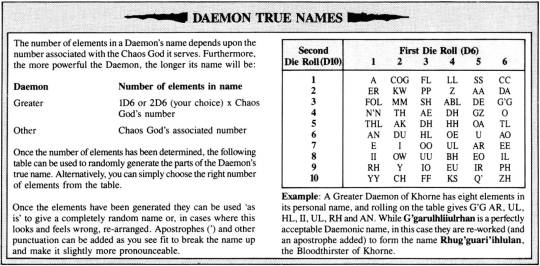
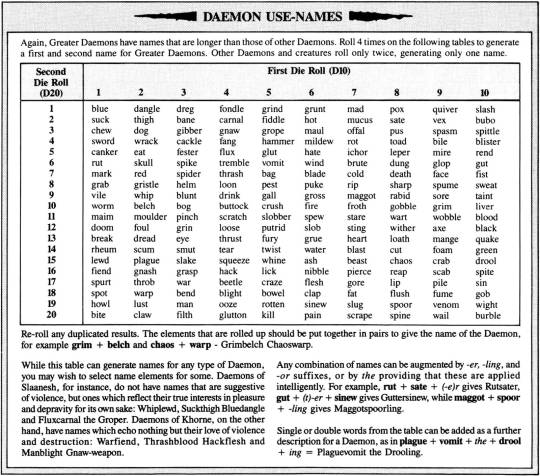
“The names of the Daemon are many and terrible. A thousand names in a thousand tongues, and each of them a lie.” Daemon name random tables from White Dwarf 102, June 1988, by Mike Brunton and Bryan Ansell, originally appearing in Realm of Chaos: Slaves to Darkness.
#daemon#daemons#Chaos#Warhammer#White Dwarf#WHFB#random tables#Games Workshop#GW#Mike Brunton#Bryan Ansell#Warhammer Fantasy Roleplay#40K#Rogue Trader#Warhammer Fantasy Battle#WHFRP#demons#Realm of Chaos: Slaves to Darkness#Realm of Chaos#Slaves to Darkness
937 notes
·
View notes
Text
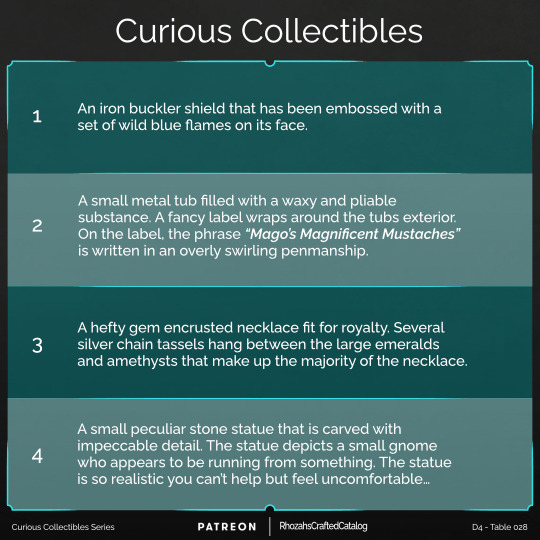
More weekend means more Curious Collectibles tables of course!
A unique shield with hidden properties?
Need a new look or want to impress at the next festival?
What is such an elaborate necklace doing laying in the street?
Do those statues have pores... and tears?
What option would you choose?
This table is available, free for you to use in your home DnD / Pathfinder / Tales of the Valiant / Daggerheart / TTRPG games, to help generate some more descriptive loot and treasure options perfect for a new quest-hook or a truly epic reward.
If you love ttrpg stuff like these and want access to more options for your Dungeons and Dragons or Pathfinder game as well as a hoard of printable paper minis, terrain and monsters to help fill your table, check out my Patreon page! I create affordable paper minis, VTT Tokens and more, with a release every week! You can follow for free so you never miss a drop or join as a member to get access to all the extra Patreon exclusive goodies.
#dnd#d&d 5e#d&d#dnd resources#dungeons and dragons#dungeon master#dnd campaign#dnd5e#d4 table#critical role#daggerheart#random tables#Curious Collectibles Series#dnd loot table#worldbuilding#ttrpg#ttrpg community#dm tools#dnd inspiration#roll tables#dnd 5th edition#pathfinder#pf2e#pathfinder 2e#rpg#dice#game master#ttrpg resources#dnd homebrew
18 notes
·
View notes
Text
RANDOM ARMY BUILDER FIGURE GENERATOR!
So, as a follow-up to the "build your character like a Ninja Turtle" thing I did based on @therobotmonster's idea, I figured I may as well come up with another one inspired by a fun, silly thing from toy-collecting: Army building mooks!
So...
What sort of Mook are they?
Humanoid
Android/Cyborg
Fleshy Undead
Plant/Fungus
Mineral
Humanoid Animal (Vertebrate)
Alien
Nonhumanoid Robot
Skeleton
Rideable Mount For Other Mooks
Monster-Person
Magic Construct/Doll
Bound Energy/Element/Force
Demon
Alien
Gynoid
Spirit/Ghost
Cosmic Horror
Animate Inanimate Objects
Rideable Vehicle For Other Mooks
What sort of antagonist or force do they work for?
A Dreadful Virus Or Corruption
Advanced Ancient Civilization That Wishes To Rule Again
50s/80s-Type Stylized Street Gang
The Good Guys (Sincere, Bad At It)
PIRATE KING!
The Legions of an Evil Wizard
Satan Or Some Stand-In Parents Won't Whine About
Conquest-Hungry Space Empire
Evil Corporate Capitalist Bastards
The Shiny Pretty "Good Guys" (Secretly Evil)
A Hunger Beyond Time And Memory
Guards/Mancatchers For A Super-Prison
Dishonorable Ninja Clan
AI Either Gone Insane Or Far Too Sane
We Will Assimilate You (AKA Fun With Biopolitics)
Some Variety of Mafia
To Stop The Evil I Must Become Evil (AKA Fallen Heroes)
There's Some Time Travel Shenanigans/Bullshit Going On Here
Big Monster(s) That Think They're The Top Of The Great Chain Of Beings
I Can't Believe It's Not A Mashup Of The Nazis And The Modern US Military
What sort of environment does this mook generally work in?
Jungles
Deserts
Urban Areas
Icy Biomes
Deep Space
Underwater/Ocean
Underground
Swamp
Mountains
Anywhere/Generalist
Cyberspace
Ancient Dungeons/Tombs
Toxic Wastelands
The Sky/Floating Islands
Haunted Places
Prehistoric Ecosystems
Jideigeki/Anime-Type Japan
Volcanoes
Inside A Monster And/Or Fleshy Meat-World
The Future!
What sort of toyetic gimmick does this particular mook type have?
Self-Destruct
Pullback Motor
Vac-Metalized Parts
Hidden Integrated Weapons
Slime Dripping
Grapples/Imprisones Other Figures
LED Lights
Removable Organs/Internal Circuitry/General Guts
Water Squirting
Translucent Plastic
Multiple Interchangable Integrated Weapons
Flapping Wings/Tendrils
Glow in the Dark
Excessive Projectile Launchers
Spinning Blade/Drill
Biting Jaws
Parasitizes Other Figures and/or Vehicles/Mounts
Full of Tinier Men
Excessively Large
Roll Twice
What sort of toyetic gimmick do they have toyline-wide? (Roll once if you're rolling multiple "figures" from the same "line" on this table)
Holograms
Attachable Armor
Spring-Loaded Melee Attack
Comes With A Little Buddy
Magnets
Spring-Loaded Projectiles
Unusual Packaging Integrated Into the Play Pattern
Interchangeable Parts
Collectible Action Figure Game (Yes, That's A Thing)
Transforming
Integrated Shiny Jewel
Some Variety of Slime
Combining
Rooted Hair
Marble Launching
Integrated Speaker/Sound Chip
Pocket-Sized (Think Battle Beasts or Food Fighters)
Die-Cast Parts
Cap Firing
Roll Twice
Have fun!
#random charts#random tables#action figure#toy#toys#toyetic#toy design#army builder#army builders#mooks#minions#no not those ones
22 notes
·
View notes
Text
Into the Perilous Wilds
I can clearly remember when I took my first, tentative steps into the hobby that would ultimately become my lifelong obsession. Sitting in a Walden Books on the floor, flipping through one of the Monster Manuals for Advanced Dungeons and Dragons and marveling at the artwork while I read the bits of lore written on the page to accompany it. After that, the first Table Top RPGs I ever played were, first, Shadowrun and that black book AD&D with the Barbarian on the cover.
This was an era where the Gamemaster was considered like unto a god. Prevailing Gygaxian advice was that players should defer to the GM's judgement and that the GM themselves should deeply understand the lore of their world, have answers for everything, be able to make harsh but impartial decisions on the spot. It was a point of view that had a huge impact on what I thought it meant to play TTRPGs and especially what it meant to be a GM for a very long time and would not change until much later in life when I encountered the indie revolution that swept through the space around the end of 3.5e/beginning of 4e when Powered by the Apocalypse games had their day in the sun.
PBtA games were the first games I really encountered that called out the idea of collaborative storytelling to an extent that caught my attention. They told you to ask your players their opinion, and featured moves with advice to ask the player themselves where they might have learned the information they new in character. These were questions that had implications on the lore of the world. In a heartbeat your players, rather than you as the godhead of the game, could shift the entire world in tone, or even turn the whole thing on its head. You might still control the Fronts, and the world itself might still be your character to play, but suddenly everyone had the creative freedom to change things in new and interesting ways baked into the mechanics of the very game.
I loved it.
Fast forward a few years and I would encounter a funny little book called The Perilous Wilds, a supplement for the PBtA game Dungeon World.
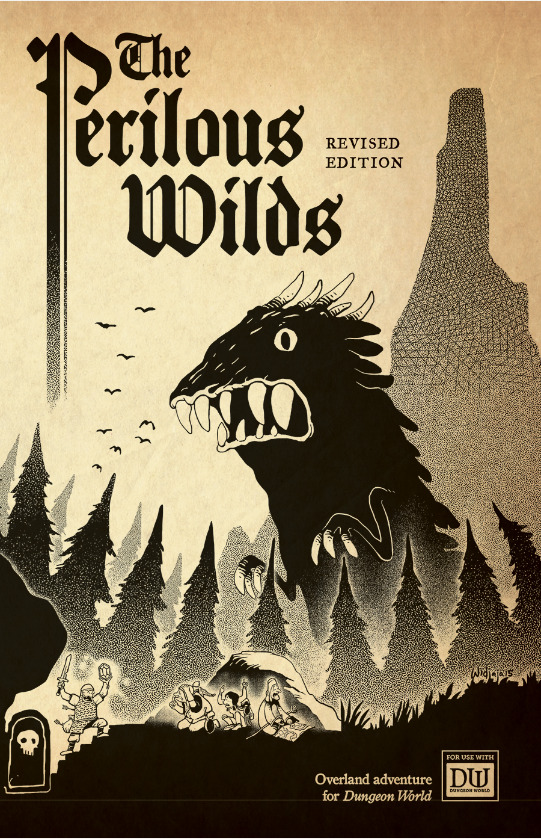
This little book is 76, digest-size pages, and had such a simple pitch:
The Perilous Wilds combines Dungeon World's approach to collaborative world-building with the old-school RPG reliance on random tables to generate content on the fly, woven together by modifications to the original Dungeon World travel moves. The main differences between the use of tables in The Perilous Wilds and their use in older RPGs is an emphasis on exploration and discovery over combat encounters, and the baked-in methodology of using randomized results as prompts rather than facts, to be interpreted during play.
The collaborative map-making guidelines and all of the tables are system-neutral (usable with any RPG rules). Although the tables are structured to tie directly into the rewritten travel moves, they can be used in any game in which a fantastical landscape is explored.
It was in this little book where I found a concept that was, perhaps not new, but one that I was incredibly taken with. Letting the players draw the map, and by extension, the world.
Starting from a discussion of the fiction of your world, be it a village on the frontier or even en media res as you emerge from a ruin temple into the wilds, you had your players a blank sheet of paper with a simple X on the map that says you are here. From there, you start with the youngest character in the party and proceed clockwise around the table. Each player is given the opportunity to add a region to the map, be they a swath of land or a sea, defined by either their prevailing terrain type or political boundaries, and then give that region a name. This step can be repeated as many times around the table as you like, but eventually you have to move on.
From there, each player is asked to places to the map. Areas, Steadings, and Sites get injected into the map, starting from the Fiction of which character is the most well traveled. Areas are like sub-regions, calling out interesting exceptions to a Region's overall theme. Steadings label the settlements of the territory, its villages, towns, keeps, or cities. Sites meanwhile, create your points of interest and landmarks. Each of these is meant to be given a brief description and name, the process continuing until everyone is satisfied with the amount.
After this the Oldest Character steps up and begins adding personal places. The book asks them to name two things: The place the character calls home and a place the character finds significant to them. These can be places already on the map, or newly named and added details like in the previous step, but the question must be answered of each: why? Why does your character choose to dwell where they do? What important thing happened to you at the point you've marked on the map? It tells you to shape the fiction of both the world and the character by considering such a simple but necessary detail.
After that, each player gets the chance to add connectors to the map in the form of roads, rivers, paths, or leylines. Anything that can be reasonably considered to connect to places within the world. Name it now, or name it later, but they must be drawn on the map as you further define the territory.
Finally, the book asks the most knowledgeable character to begin the process of sharing rumors and legends. Something the character has heard about any place on the map, but something that no one in the party can be sure to be true or false. The rumors must be noteworthy and provocative, the book advises, but each player has the chance to add to the depth of the fiction. Cutely, the book even offers the following advice:
This conversation might happen in character, or not. Ask clarifying questions; chide the speaker for giving any credence whatever to such malarkey; whistle in awe at the very idea.
And meanwhile the book itself speaks directly to the Game Master and asks you consider which of these rumors is really true, and what does that mean for the world?
All of this is excellent advice, and the procedure itself has been fun and engaging to work with every time I have put it to use in one of my games. It's also one of the primary reasons that I took to Fabula Ultima with such gusto, after reading that game's own advice and procedure on how to build a world. The two products are aligned in their ideals of what it means to create a world for cooperative storytelling, and the similarities in their process was striking.
But it goes beyond merely that.
The book is filled to the brim with interesting mechanics for the game Dungeon World, including new rules for followers and overland travel, Moves for handling the weather and compendium classes for your players to level into, but even past the mechanics built specifically for one game in particular, there are so many tables and system agnostic little details.
There's a Monster maker, a Discovery generator, Steading creator, and so much more. There are tables for creating quirks and details for people, places, and things, and a section that provides a whole array of rules for generating dungeons on the fly who's details can be fleshed out as you go and it's layout can be easily represented by a flowchart rather than meticulous lines drawn on graph paper.
And most importantly, the book simply tells you to trust your gut.
Yes, it offers you advice on how to prep between sessions, but it advises that a little bit of prep can go a long way. You don't need to worry about having all of the answers. Your campaign bible need not be so thick that you could bludgeon someone to death with it. All you really need is a sense of what is happening in the world and your gut instinct as a storyteller. You really only have to take a step back think more deeply on the game, its Fronts and its people and places, if you begin to sense instability in the world's fabric that you or your players find intolerable. With practice, the book says, you shouldn't need more than an hour or so between sessions to make the minimal, necessary notes for what comes next.
It's an excellent little tome, and one which I still use to this day, even though we're not currently playing any Dungeon World games. The tables provide me with rich inspiration and quick in-game answers to the question of what comes up during exploration. Its dungeon generation system has taught me that in theater of the mind play, a node map can be just as useful as a real one.
And when I feel my dedication to the ideal of collaborative world building and storytelling slipping because I want more answers or more control, I flip through its pages and read its advice as a reminder that we don't have to live in the castles that Gygax built any longer.
#ttrpg#indie ttrpg#Perilous Wilds#Dungeon World#inspiration#random tables#collaborative storytelling#world building#fabula ultima#pbta
46 notes
·
View notes
Text
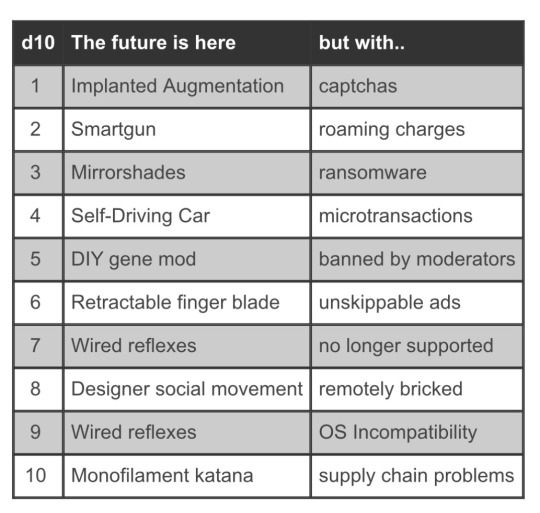
The Cyberpunk We Got
Taking a covid test in a car speeding through the rain at night feels very cyberpunk. International travel, backseat chemistry.. all I need is a red dot sight on me from a blacked out Mercedes. That makes up for it all.. right?
I guess you can have column A, but not without a little column B.
—Michael Prescott
22 notes
·
View notes
Text
cy_borg as a ttrpg fucking rules and is an ultrastylised loveletter to the Punk in cyberpunk. also the randomised character style table is so fucking good

108 notes
·
View notes
Text
Fantasy Culture Tables: Beauty and Fashion Standards
Meant for your next city, group or counter culture, as a random table or list of ideas
Practicality. Clean and simple clothes, work minded builds and minimal cosmetics. To be honest, most don’t have the time to beautify.
A specific color. Perhaps it’s a dye hard to come across normally, perhaps it’s associated with a figure of power, but if you’re not wearing it, you’re on the outs.
A lack of color. Perhaps it’s because of a reverence for rouges, perhaps a local designer has deemed it flattering, but gaudy or colorfully dressed members of adventuring parties are sure to stand out.
Thick/covering clothing. Perhaps fabric is a sign of status, perhaps weavers are considered culturally important, but at the end of the day showing skin is for those who don’t care about fashion.
Revealing clothing. Though some may think they know the motivations, in reality this is a largely practical matter. Perhaps the local aasimar population needs a bare back for the health of their wings, or the local drow can only absorb the moon through bare skin, so their nightclothes cannot cover much.
Excess. Crazy patterns, jewelry, even face paint is an easy way to show off your creativity, which they treasure here. So go big or go home.
Jewels and metals. Perhaps thanks to proximity to a mine, perhaps reverence for a gem dragon, the marker of a good member of that society is indeed the gems on their body.
Capes. The material, color and length can tell you everything you need to know about someone from this place. Perhaps any party members wearing one will want their own checked out to prevent… false information.
Combat readiness. Armor is high fashion, sharp teeth or claws can draw in any partner you want, and those looking unequipped? Well the locals feel sorry for them indeed.
Religious inspired. Perhaps it’s wearing the holy symbol of a certain figure on any garment you can, perhaps it’s copying a famous depiction of the figure, but everyone knows the ultimate example of beauty has to be divine.
Tattoos. Complex pictures of life events and achievements tell the story of a person and determine if a person is worth talking to. An individual without them will certainly be a fascinating sight to behold.
Bone. In jewelry or on armor, wearing bone here is a way to mark yourself in charge of the monsters around the area, a trophy to wear with you. Maybe this place adores the exposed bone of tiefling horns as well.
Dual-function clothes and accessories: Hidden swords and knives, lock picks and sheaths are the heights of fashion and yet somehow this community trusts each other completely.
Flowers. From patterns to wearing them in one’s hair, connection to flowers is vital here. What they mean is too, so choose accessories cautiously.
Moving clothing and accessories: In a place that reveres artificers, a mechanical movement to your glasses or a skirt whose hoop can part to allow access up stairs is considered a massive status symbol. Especially if somehow, you helped make it personally.
Masks. In a place where identity is precious as secrecy, it is wise to cover your face. Not because you are more beautiful, but because He may know you if you don’t.
Heirlooms. Everything may look old, but any local knows the value of the story it holds. Locals will ask, so what will your party say?
Dead things. Skulls, decayed tree bark and rotted materiel show a maturity here, an acceptance and love of what comes after. Perhaps it’s thanks to a death god’s influence, perhaps something less direct, but the locals will show off clothing many may call creepy with great pride.
Text. Usually written in the lining of a suit coat or in a jewelry piece, it is expected the words a person wears are the ones they live by. But beware of reading any local’s words, especially aloud. You do not know the magic they might hold.
Illusion magic. Here, there’s only one thing no one looks like: Themselves. No one’s face is their own, and it doesn’t seem to bother them, but no one around seems to tell anyone why. Then it occurs to you: Do they even remember?
#d&d#d&d 5e#dungeons and dragons#dungeons and dragons 5th edition#d&d homebrew#worldbuilding#random tables#fantasy world building#world building
2 notes
·
View notes
Text

You’ve encountered the Cryptic Caravan roll for loot!
Roll a d10 here & collect your junk👇
1. deck of tarot cards, a pair of cloth gloves, a vial of quicksilver
2. brass bell (1 gp), a tinderbox (5 sp), a vial of perfume (5 gp)
3. dragon's tooth, a patch of chainmail
4. flask of ale, a herbal poultice
5. ring of iron keys, an apple core, scraps of leather
6. set of fine brushes (5 gp), a signet ring (5 gp), some garlic
7. page torn from a spellbook, a small iron ingot
8. boiled egg, a list of local taverns, a vial of blood
9. drafting compass (1 gp), bent nails
10. magnifying glass (100 gp), a page torn from a spellbook, the deed to a small property
#dnd#dnd prompt#random encounters#random tables#ttrpg#ttrpg community#dungeons and dragons#dnd stuff#dnd lore#game loot#cryptic#caravan#cryptic caravan#writing#writing prompt#dnd character#dnd questions#dm#dm tips#gm#gm tips#dm tools#gm tools
23 notes
·
View notes
Text

I LOOT THE GOBLIN! 👹🍄🌿
Embark on a goblin looting spree with this random treasure table and enrich your campaign's loot rewards!
6 notes
·
View notes
Note
a table of odd magic items that may or may not be useful
“…the GM will only tell you something interesting—it’s on you to make it useful.” — Dungeon World
1d20 Magical Items of Mild Utility
A doorknob that can be easily affixed to any door by simply holding it on for about thirty seconds. Once affixed, it permanently transforms into an ordinary doorknob and lock, to which you have the key.
The Shaker of Infinite Salt
A pencil that significantly improves the user’s penmanship when writing with it.
An orb containing a very small pocket dimension, into which one can transfer their familiar so that it may safely rest.
A palm-sized stone figurine of a shark, which will bite any fingers that come near its mouth.
Self-Fluffing Pillow
Watch that shows you what time it was the last time you looked at the watch, instead of what time it is now.
Piece of string that, when tied around your finger, actually helps you remember to do that thing.
Temporary Scissors: They can only cut the normal things you’d expect from a pair of scissors, but if you hold the cut pieces together tightly they will magically re-form into a whole, as though they’d never been cut.
Robes that make the wearer an inch or so taller.
Magic Eraser (erases pencil, ink and crayon!)
Hand-sized stone that, when thrown, always lands 5 feet in front of your intended target—whether your aim is perfect or abysmal.
A bucket that transforms any liquid poured into it into seawater.
A bar of soap that temporarily changes the color of anything washed with it. The color is random, and changes each time the bar is used (1d6: 1: Red, 2: Orange, 3: Yellow, 4: Green, 5: Blue, 6: Purple). The color lasts one day.
Goggles of Shrimp-Color Vision
A ring with a single very round stone. When you say the magic word the stone pops out and transforms into a bowling ball. It turns back into a small stone after 2d4 hours and must be manually returned to the ring before it can be used again.
Boots that produce an animal sound of your choice when you jump up and do a jaunty little bell-kick while wearing them.
A small glass bottle that, when filled with water, appears instead to be full of a swirling, shimmering potion.
A quiet trumpet.
A knife that can only cut sandwiches. It is up to the GM’s discretion what does and does not count as a sandwich for this enchantment, but the rules are consistent.
#whoops i cant believe it took me an entire month to get to this request i apologize ^^'#random table#random tables#ttrpg#ttrpg community#ttrpg homebrew#homebrew#fantasy#dnd#d&d#dungeons and dragons#dnd homebrew#dnd table#random item table#random treasure table#items#treasure#loot#random loot#random loot table
352 notes
·
View notes
Text
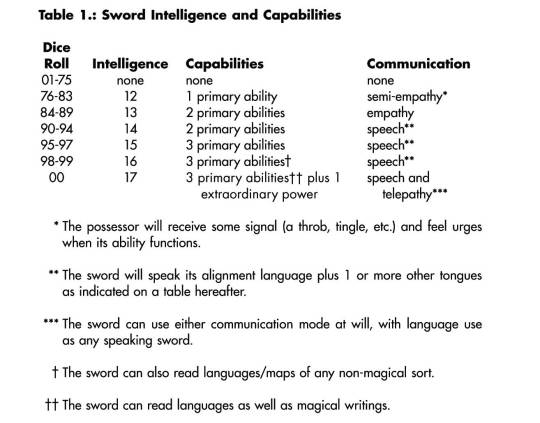
Looking further at the magic treasure tables in the 1979 AD&D DMG, we see that 25% of magic swords are supposed to be intelligent and have additional special abilities. One thing that stands out from a modern perspective: result "00" tell us that only 1% of all magic swords (1 in 25 of the intelligent swords) have the option of using telepathy. Other intelligent swords that can communicate directly have "speech." This implies that the entire party, and NPCs and monsters in the area, will hear some swords speaking out loud. Today many DMs play all intelligent weapons as speaking telepathically to the wielder while the rest of the party only sees that one character is beginning to act oddly.
Note all intelligent swords add 1-3 "primary abilities" from another table, all designed for treasure hunting and dungeon exploration:

(Keep in mind AD&D's 1" = 10' in the dungeon or 10 yards in the wilderness.)
The rare "Extraordinary Power" can make a magic sword into something akin to a legendary artifact, when combined with 3 primary abilities and whatever base abilities the sword initially had from Table III.G:
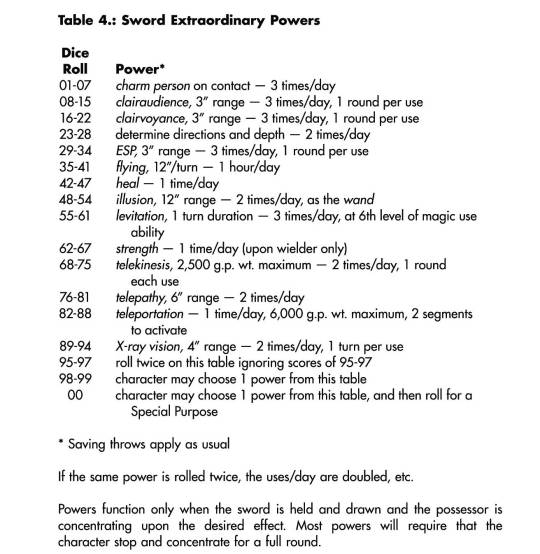
The sword rules continue for another page with tables and clarifications for alignment, languages, ego, personality conflicts with the wielder, and those extremely rare "Special Purpose" swords mentioned on the Extraordinary Powers table which are driven to defeat a specific class of enemy and are enchanted with yet another random magic power used only for that goal.
#D&D#Dungeons & Dragons#AD&D#Dungeon Masters Guide#intelligent magic swords#magic sword#magic swords#gaming history#DMG#Gary Gygax#random table#random tables#dnd#Dungeons and Dragons#TSR
203 notes
·
View notes
Text

Another weekend is rolling in and what better to have than another roll on a new Curious Collectibles table of course!
Who was trying to hide the name of this old journal and why?
What could this odd contraption be used for?
Could this signet be from one of the fallen knights?
Is this a scam or a real potion? Do you dare open it to find out?
What option would you choose?
This table is available, free for you to use in your home DnD / Pathfinder / Tales of the Valiant / Daggerheart / TTRPG games, to help generate some more descriptive loot and treasure options perfect for a new quest-hook or a truly epic reward.
If you love ttrpg stuff like these and want access to more options for your Dungeons and Dragons or Pathfinder game as well as a hoard of printable paper minis, terrain and monsters to help fill your table, check out my Patreon page! I create affordable paper minis, VTT Tokens and more, with a release every week! You can follow for free so you never miss a drop or join as a member to get access to all the extra Patreon exclusive goodies.
#dnd#d&d 5e#d&d#dnd resources#dungeons and dragons#dungeon master#dnd campaign#dnd5e#d4 table#critical role#daggerheart#random tables#Curious Collectibles Series#dnd loot table#worldbuilding#ttrpg#ttrpg community#dm tools#dnd inspiration#roll tables#dnd 5th edition#pathfinder#pf2e#pathfinder 2e#rpg#dice#game master#ttrpg resources#dnd homebrew
7 notes
·
View notes
Text
"Build Your Character Like A Ninja Turtle" Random Tables
So, Friend of the blog Trent Troop, AKA @therobotmonster came up with a great concept called "Build Your Character Like A Ninja Turtle," with the idea of building a character via a combination of "Species/Type + Job/Skill + Schtick"
So, naturally I had to make some random D20 tables for doing that process, trying to go a bit broad and open-ended with it for maximum fun! Along with an optional bonus one to fit with Trent;'s toyetic aesthetics.
Roll once on each table to do the basic process or, for added fun, roll twice and try to combine the two results on each you roll up in an interesting way! (Re-rolling if you get doubles obvz)
Species/Type
Post-Human
Goblin
Fish
Arthropod
Furry Mammal
Alien
Body Part (Eye/Brain/Organ/Extremity/ect)
Robot/Cyborg
Demon/Devil
Dinosaur/Dragon
Mollusc
Mineral
Plant
Armored
Amphibian
Garbage
Undead
Avian
Elemental
Abomination
Job/Skill
Soldier
Sports-Person
Secret Agent
Wizard/Magician/Witch
Cowboy
Barbarian
Ninja
Martial Artist
Mad Scientist
Bounty Hunter
Doctor/Nurse
Greaser/Biker
First Responder/Rescuer
Animal/Creature Handling
Pilot/Driver
Musician
Clown
Construction/Maintainance/Demolition
Body Horror
Superhero
Schtick
True Hero
The Starscream
Pretentious Artiste
Angsty Loner
Lacksidaisical Jokester/Party Dude
Courageous Coward
Hippie
Goth
Autistic-Coded Nerd
Escaped Experiment/I Am Not A Gun
Boisterous Bruiser/Himbo (Gender Neutral)
Lovable Rogue
Stoic and Scary
Wise Mentor
Tsundere/Yandere (Gender Neutral)
Don Quixote-Type Delusional
Cynic With A Heart Of Gold
Fussy And Respectable Neat Freak
They Everything Hide A Basic Insecurity
Supreme Villain
Optional: Toyetic Gimmick
Miniaturized
Scented
Sparking
Color Changing
Translucent Plastic
Water Squirting
Glow In the Dark
Modular/Interchangable Parts
Missile-Firing
Transforming
Slime Dripping
Lights & Sound
Battle Armor
Spring Loaded Action Feature
Vac-Metalized Plastic
Covered In Fur
Magnets
Pumping Fluids
Self Destruct
Extremely Big
So... Have fun!
Also, since this was inspired by the man's work, if you like this, please donate to Trent's Gofundme and/or Paypal if you can afford it.
He's fallen on some hard times, and he deserves so much better from this world...
#random table#random tables#titlewriting#character design#character concepts#random generation#random generator
65 notes
·
View notes
Text
Statistically Accurate Character and Crime Generation Tables for Baltimore City and Greater Maryland for RPGs - use for supers or any modern RPG to generate statistically accurate characters and random crimes.
While put together for a supers game in Baltimore City using the DC Heroes RPG(in a combined Marvel/DC universe), this could be used in any major city, or adapted based on your own city's statistics, for any kind of modern game where generating realistic characters and/or crimes(for patrol tables, etc) are useful.
#rpg#rpgs#supers#super heroes#super hero rp#superheroes#character generator#character design#dc heroes#marvel superheroes#dc heroes rpg#crime statistics#random tables
2 notes
·
View notes
Text



A set of d66 tables for generating Books of a Magical & Occasionally Dark Nature.
#d66#random tables#book title generator#random book generator#wizardcore#necromancy#demonology#summoning#conjuration#dnd#ttrpgs
8 notes
·
View notes